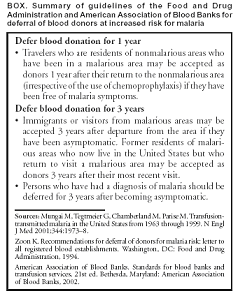 |
The next step in the investigation of this case is a donor traceback
of the 4 units of packed red blood cells (PRBC) used for this patient’s
transfusions. This traceback includes:
- Collection and testing of segments from the original collection
bags or bags of donated products from each donor. Segments are tested
for presence of malaria parasites with microscopy and PCR, and for
malaria antibodies using IFA
- If blood bag segments are not available, collection of blood specimens
from donors for microscopy, PCR and IFA
- Identification of suspect (or sometimes all) donors and an assessment
of their risk factors for malaria. This should include asking about
recent travel history, past malarial infection, recent febrile illness
(particularly since time of donation), recent transfusion/transplants,
and IV drug use
If a donor is implicated, tracing of all products donated by this individual
is essential. Any other recipients of this donor’s products will
need evaluation and may need testing and treatment.
The implicated donor
should also be treated (depending on species).
N.B. Persons acquiring
either P. vivax or P. ovale infection
through blood transfusion DO NOT require primaquine
therapy. No liver stage (hypnozoites) develops with this mode of
infection.
The blood bank should remove the donor from the donor pool as appropriate
according to the FDA guidelines (Box).

Page last modified : April 23, 2004
Content source: Division of Parasitic Diseases
National Center for Zoonotic, Vector-Borne, and Enteric Diseases (ZVED)
|
 |
|



